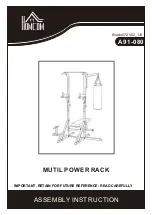
Page 57
Figure 7-4. Connections for insulation resistance measurements.
1) Measurement of windings of the rotors.
2) Measurement of the stator winding of the excitation machine. M represents
the insulation resistance meter.
7.6.5 Polarization index
For the polarization index test the insulation resistance is measured after the
voltage has been applied for 15 seconds and 1 minute (or 1 minute and 10
minutes). The polarization index test is less dependent on the temperature than the
insulation resistance. When the winding temperature is below 50 °C (122 °F), it
may be considered independent of temperature. High temperatures can cause
unpredictable changes in the polarization index; therefore the test should not be
used in temperatures above 50 °C (122 °F).
Dirt and humidity accumulating in the winding normally reduces the insulation
resistance, and the polarization index, as well as their dependence on temperature.
Thus, the line in
Figure 7-2. Correlation between the insulation resistance and the
temperature
becomes less steep. Windings with open creepage distances are very
sensitive to the effects of dirt and humidity.
There are several rules for determining the lowest acceptable value with which the
machine can be safely started. For the polarization index (PI), the values usually
range between 1 and 4. Values close to 1 indicate that the windings are humid and
dirty.
The minimum
PI
value for class
H
stator winding is more than 2, where:
s
R
R
PI
15
min
1
=
or:
min
1
min
10
R
R
.
NOTE: If the insulation resistance of the winding is in the range of several
thousands of M , the polarization index is not a meaningful criterion of
the condition of the insulation, and it can be disregarded.
7.6.6 High voltage test
A voltage test is used to check for electrically weak spots in the windings that
may lead to insulation failure during servicing. It is carried out during major
inspections, troubleshooting and repairs.
AC voltage is used for the high voltage test and the test voltage is 1500 V.














































